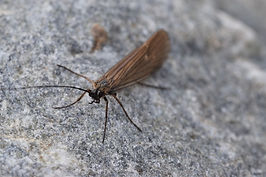The Magnificent Life of a Caddisfly


By Sam Nunes, Environmental Educator,
Now is the time of year when you look down in the water in swamps and you see little bundles of leaves, sticks, and stones that seem to have sprouted legs and wiggle around under the water. In a way they have — in the center of that detritus mound is a larval caddisfly!
Caddisflies are small, winged insects closely related to moths and butterflies. They have been around since the Jurrassic period around 185 million years ago. Although they have wings as adults, they actually start their life cycle under water. The adults lay their eggs in the water: They deposit the eggs on the water surface and they sink, or they put the eggs on a leaf next to the water to be washed in by the rain, or they actually can swim down and deposit the eggs underwater themselves.
What’s really cool about caddisflies is that the larvae have adapted this amazing ability to build portable shelters around them using sticks, plant clippings, stones, and whatever else they can find. They do this by creating silky fibers that hold it all together. There are around 14,000 known species of caddisflies, and different species use different materials. Each house is a unique representation of the environment they hatch into.
When caddisflies reach the pupa stage, they emerge from their homes and swim to the surface. Similar to dragonflies, they emerge from their juvenile forms, dry out their wings, and then take to the air. To add more drama, there are many species of fish and amphibians who would love to eat caddisflies. Their homes offer them protection during their larval stage but this metamorphosis stage is very dangerous for our bug buddies. As adults, caddisflies live for about a month before laying eggs again. Because their adult lives are so short, they actually don’t develop full mouths, but some can suck liquid nectar from plants. This way they can focus on the most important thing at this stage of life — reproduction.
Caddisflies are a very important link between aquatic and terrestrial ecosystems. They take energy from the aquatic plants they eat. That energy is then transferred to the fish, frogs, and birds that eat the caddisflies.
So get out this spring and see how many different caddisfly homes you can find.






